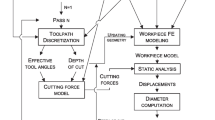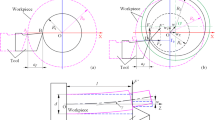Abstract
A finite element model was established for analyzing the geometric errors in turning operations and a two-step analyzing process was proposed. In the first analyzing step, the cutting force and the cutting heat for the cutting conditions were obtained using the AdvantEdge. Also, the deformation of a workpiece was estimated in the second step using the ANSYS. The deformation was analyzed for a 150 mm-long workpiece at three different measuring points, such as 10, 70 and 130 mm from a reference point, and the amounts of the deformation were compared through experiments. In the results of the comparison and analysis, the values obtained from these comparison and analysis represent similar tendencies. Also, it is verified that their geometric errors increase with the increase in temperature. In addition, regarding the factors that affect the deformation of a workpiece, it can be seen that the geometric error in the lathe is about 15%, the error caused by the cutting force is about 10%, and the deformation caused by the heat is about 75%.
Similar content being viewed by others
References
MASUDA M, TORRI M. The influence of cutting force on boundary failure of cutting tool [J]. Journal of Japan Society Precision Engineering, 1987, 53(10): 1596–1601. (in Japanese)
YANG S, YUAN J, NI J. Real-time cutting force induced error compensation on a turning center [J]. International Journal of Machine Tools and Manufacture, 1997, 37(11): 1597–1610.
LEVY E K, TSAI C L, GROOVER M P. Analytical investigation of the effect of tool wear on the temperature variations in a metal cutting tool [J]. Trans ASME, 1976, 98(1): 251–257.
NG E G, ASPINWALL D K, BRAZIL D, MONAGHAN J. Modeling of temperature and force when orthogonally machining hardened steel [J]. International Journal of Machine Tools and Manufacture, 1999, 39(6): 885–903.
KIM K W, SIN H C. Development of a thermo-viscoplastic cutting model using finite element method [J]. International Journal of Machine Tools and Manufacture, 1996, 36(3): 379–397.
SHIH, ALBERT J. Finite element analysis of orthogonal metal cutting mechanics [J]. International Journal of Machine Tools and Manufacture, 1996, 36(2): 255–273.
LEE M J, LEE C M. A study on the development of analysis model for prediction of relative deformation between cutting tool and workpiece [J]. Journal of Korean Society Precision Engineering, 2010, 27(4): 20–26. (in Korean)
WU H Y, LEE W B, CHEUNG C F, TO S, CHEN Y P. Computer simulation of single-point diamond turning using finite element method [J]. Journal of Material Processing Technology, 2005, 167: 549–554.
TOPAL E S, COGUN C. A cutting force induced error elimination method for turning operations [J]. Journal of Material Processing Technology, 2005, 170: 192–203.
BENARDOS P G, MOSIALOS S, VONSNIAKOS G C. Prediction of workpiece elastic deflections under cutting forces in turning [J]. Robotics and Computer-Integrated Manufacturing, 2006, 22: 505–514.
WANG X, DA Z J, BALAJI A K, JAWAHIR I S. Performance-based predictive models for turning operations and applications: Part III. Optimum cutting conditions and selection of cutting tools [J]. Journal of Manufacturing Processes, 2007, 9(1): 61–74.
KUNDRAK J, KARPUSCHEWSKI B, GYANI K, BANA V. Accuracy of hard turning [J]. Journal of Materials Processing Technology, 2008, 202(1/2/3): 328–338.
WANG X, DA Z J, BALAJI A J, JAWAHIR I S. Thermal error optimization modeling and real-time compensation on a CNC turning center [J]. Journal of Material Processing Technology, 2008, 207(1/3): 172–179.
BENARDOS P G, MOSIALOS S, VOSNIAKOS G C. Prediction of workpiece elastic deflections under cutting forces in turning [J]. Robotics and Computer-Integrated Manufacturing, 2006, 22(5/6): 505–514.
TZENG C J, LIN Y H, YANG Y K, JENG M C. Optimization of turning operations with multiple performance characteristics using the Taguchi method and Grey relational analysis [J]. Journal of Materials Processing Technology, 2009, 209(6): 2753–2759.
TZENG Y F. Parameter design optimization of computerized numerical control turning tool steels for high dimensional precision and accuracy [J]. Materials and Design, 2006, 27(8): 665–675.
KISHAWY H A, HANLUND A, BALAZINSKI M. Modelling of material side flow hard turning [J]. Annals of the CIRP, 2006, 55(1): 85–88.
YAHYA I. Investigating the machinability of tool steels in turning operations [J]. Materials and Design, 2007, 28(5): 1417–1424.
Author information
Authors and Affiliations
Corresponding author
Additional information
Foundation item: Project(RTI04-01-03) supported by the Regional Technology Innovation Program of the Ministry of Knowledge Economy (MKE), Korea
Rights and permissions
About this article
Cite this article
Lee, Mj., Lee, Cm. Development of analysis model for geometric error in turning processes. J. Cent. South Univ. Technol. 18, 711–717 (2011). https://doi.org/10.1007/s11771-011-0752-0
Received:
Accepted:
Published:
Issue Date:
DOI: https://doi.org/10.1007/s11771-011-0752-0




